英语修辞手法
英语19种修辞手法的全部解释和例句
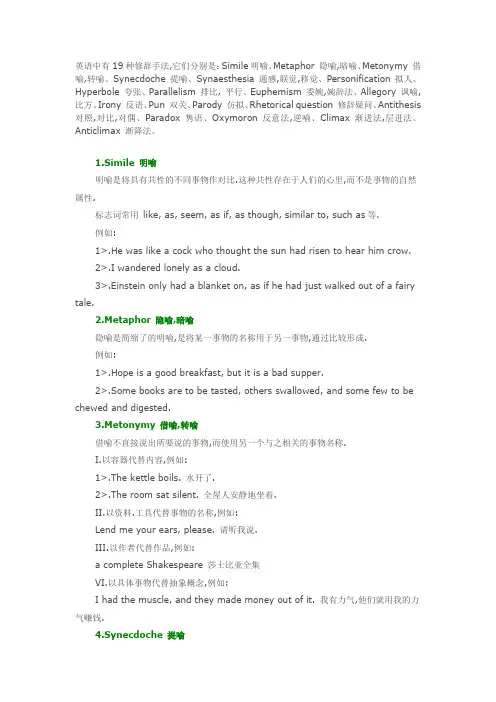
英语中有19种修辞手法,它们分别是:Simile明喻、Metaphor 隐喻,暗喻、Metonymy 借喻,转喻、Synecdoche 提喻、Synaesthesia 通感,联觉,移觉、Personification 拟人、Hyperbole 夸张、Parallelism 排比, 平行、Euphemism 委婉,婉辞法、Allegory 讽喻,比方、Irony 反语、Pun 双关、Parody 仿拟、Rhetorical question 修辞疑问、Antithesis 对照,对比,对偶、Paradox 隽语、Oxymoron 反意法,逆喻、Climax 渐进法,层进法、Anticlimax 渐降法。
1.Simile 明喻明喻是将具有共性的不同事物作对比.这种共性存在于人们的心里,而不是事物的自然属性.标志词常用like, as, seem, as if, as though, similar to, such as等.例如:1>.He was like a cock who thought the sun had risen to hear him crow.2>.I wandered lonely as a cloud.3>.Einstein only had a blanket on, as if he had just walked out of a fairy tale.2.Metaphor 隐喻,暗喻隐喻是简缩了的明喻,是将某一事物的名称用于另一事物,通过比较形成.例如:1>.Hope is a good breakfast, but it is a bad supper.2>.Some books are to be tasted, others swallowed, and some few to be chewed and digested.3.Metonymy 借喻,转喻借喻不直接说出所要说的事物,而使用另一个与之相关的事物名称.I.以容器代替内容,例如:1>.The kettle boils. 水开了.2>.The room sat silent. 全屋人安静地坐着.II.以资料.工具代替事物的名称,例如:Lend me your ears, please. 请听我说.III.以作者代替作品,例如:a complete Shakespeare 莎士比亚全集VI.以具体事物代替抽象概念,例如:I had the muscle, and they made money out of it. 我有力气,他们就用我的力气赚钱.4.Synecdoche 提喻提喻用部分代替全体,或用全体代替部分,或特殊代替一般.例如:1>.There are about 100 hands working in his factory.(部分代整体)他的厂里约有100名工人.2>.He is the Newton of this century.(特殊代一般)他是本世纪的牛顿.3>.The fox goes very well with your cap.(整体代部分)这狐皮围脖与你的帽子很相配.5.Synaesthesia 通感,联觉,移觉这种修辞法是以视.听.触.嗅.味等感觉直接描写事物.通感就是把不同感官的感觉沟通起来,借联想引起感觉转移,“以感觉写感觉”。
英语18种重要修辞手法
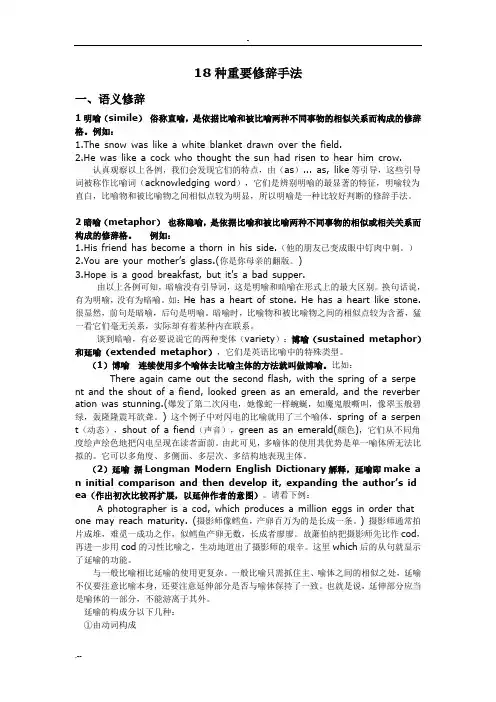
18种重要修辞手法一、语义修辞1明喻(simile)俗称直喻,是依据比喻和被比喻两种不同事物的相似关系而构成的修辞格。
例如:1.The snow was like a white blanket drawn over the field.2.He was like a cock who thought the sun had risen to hear him crow.认真观察以上各例,我们会发现它们的特点,由(as)... as, like等引导,这些引导词被称作比喻词(acknowledging word),它们是辨别明喻的最显著的特征,明喻较为直白,比喻物和被比喻物之间相似点较为明显,所以明喻是一种比较好判断的修辞手法。
2暗喻(metaphor)也称隐喻,是依据比喻和被比喻两种不同事物的相似或相关关系而构成的修辞格。
例如:1.His friend has become a thorn in his side.(他的朋友已变成眼中钉肉中刺。
)2.You are your mother’s glass.(你是你母亲的翻版。
)3.Hope is a good br eakfast, but it’s a bad supper.由以上各例可知,暗喻没有引导词,这是明喻和暗喻在形式上的最大区别。
换句话说,有为明喻,没有为暗喻。
如:He has a heart of stone. He has a heart like stone.很显然,前句是暗喻,后句是明喻。
暗喻时,比喻物和被比喻物之间的相似点较为含蓄,猛一看它们毫无关系,实际却有着某种内在联系。
谈到暗喻,有必要说说它的两种变体(variety):博喻(sustained metaphor)和延喻(extended metaphor),它们是英语比喻中的特殊类型。
(1)博喻连续使用多个喻体去比喻主体的方法就叫做博喻。
比如:There again came out the second flash, with the spring of a serpe nt and the shout of a fiend, looked green as an emerald, and the reverber ation was stunning.(爆发了第二次闪电,她像蛇一样蜿蜒,如魔鬼般嘶叫,像翠玉般碧绿,轰隆隆震耳欲聋。
英语中有19种修辞手法
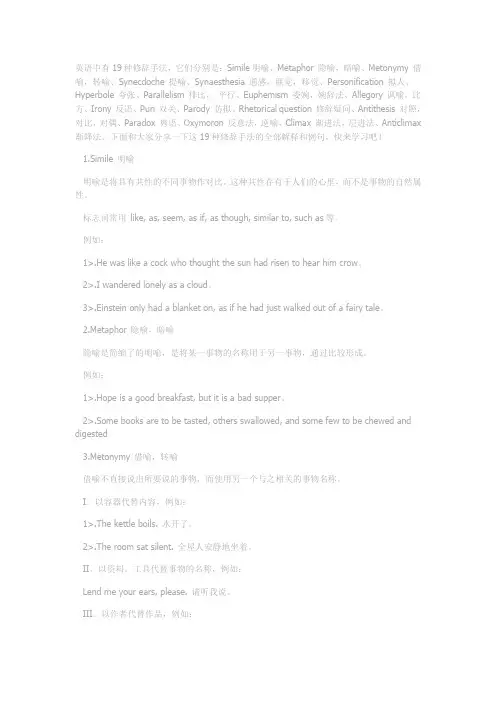
英语中有19种修辞手法,它们分别是:Simile明喻、Metaphor 隐喻,暗喻、Metonymy 借喻,转喻、Synecdoche 提喻、Synaesthesia 通感,联觉,移觉、Personification 拟人、Hyperbole 夸张、Parallelism 排比,平行、Euphemism 委婉,婉辞法、Allegory 讽喻,比方、Irony 反语、Pun 双关、Parody 仿拟、Rhetorical question 修辞疑问、Antithesis 对照,对比,对偶、Paradox 隽语、Oxymoron 反意法,逆喻、Climax 渐进法,层进法、Anticlimax 渐降法。
下面和大家分享一下这19种修辞手法的全部解释和例句,快来学习吧!1.Simile 明喻明喻是将具有共性的不同事物作对比。
这种共性存有于人们的心里,而不是事物的自然属性。
标志词常用like, as, seem, as if, as though, similar to, such as等。
例如:1>.He was like a cock who thought the sun had risen to hear him crow。
2>.I wandered lonely as a cloud。
3>.Einstein only had a blanket on, as if he had just walked out of a fairy tale。
2.Metaphor 隐喻,暗喻隐喻是简缩了的明喻,是将某一事物的名称用于另一事物,通过比较形成。
例如:1>.Hope is a good breakfast, but it is a bad supper。
2>.Some books are to be tasted, others swallowed, and some few to be chewed and digested。
(完整版)英语中的修辞手法
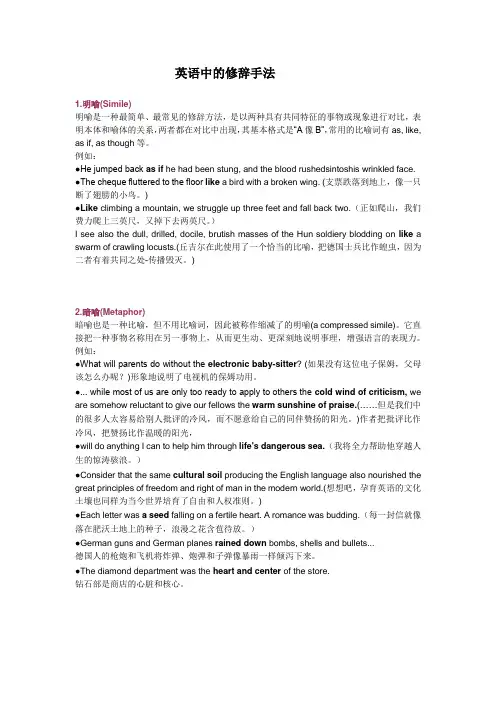
英语中的修辞手法1.明喻(Simile)明喻是一种最简单、最常见的修辞方法,是以两种具有共同特征的事物或现象进行对比,表明本体和喻体的关系,两者都在对比中出现,其基本格式是“A像B”,常用的比喻词有as, like, as if, as though等。
例如:●He jumped back as if he had been stung, and the blood rushedsintoshis wrinkled face.●The cheque fluttered to the floor like a bird with a broken wing. (支票跌落到地上,像一只断了翅膀的小鸟。
)●Like climbing a mountain, we struggle up three feet and fall back two.(正如爬山,我们费力爬上三英尺,又掉下去两英尺。
)I see also the dull, drilled, docile, brutish masses of the Hun soldiery blodding on like a swarm of crawling locusts.(丘吉尔在此使用了一个恰当的比喻,把德国士兵比作蝗虫,因为二者有着共同之处-传播毁灭。
)2.暗喻(Metaphor)暗喻也是一种比喻,但不用比喻词,因此被称作缩减了的明喻(a compressed simile)。
它直接把一种事物名称用在另一事物上,从而更生动、更深刻地说明事理,增强语言的表现力。
例如:●What will parents do without the electronic baby-sitter? (如果没有这位电子保姆,父母该怎么办呢?)形象地说明了电视机的保姆功用。
●... while most of us are only too ready to apply to others the cold wind of criticism, we are somehow reluctant to give our fellows the warm sunshine of praise.(……但是我们中的很多人太容易给别人批评的冷风,而不愿意给自己的同伴赞扬的阳光。
英语中常见的修辞手法
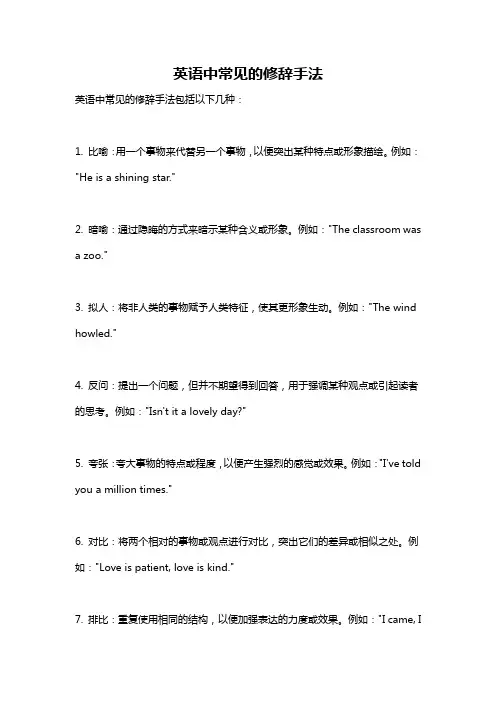
英语中常见的修辞手法英语中常见的修辞手法包括以下几种:1. 比喻:用一个事物来代替另一个事物,以便突出某种特点或形象描绘。
例如:"He is a shining star."2. 暗喻:通过隐晦的方式来暗示某种含义或形象。
例如:"The classroom wasa zoo."3. 拟人:将非人类的事物赋予人类特征,使其更形象生动。
例如:"The wind howled."4. 反问:提出一个问题,但并不期望得到回答,用于强调某种观点或引起读者的思考。
例如:"Isn't it a lovely day?"5. 夸张:夸大事物的特点或程度,以便产生强烈的感觉或效果。
例如:"I've told you a million times."6. 对比:将两个相对的事物或观点进行对比,突出它们的差异或相似之处。
例如:"Love is patient, love is kind."7. 排比:重复使用相同的结构,以便加强表达的力度或效果。
例如:"I came, Isaw, I conquered."8. 修饰语:使用形容词、副词等修饰词语,以增强其描述能力或表达感情色彩。
例如:"The sun was shining brightly."9. 双关语:使用具有多重意义的词语或短语,以产生幽默效果或引起读者的注意。
例如:"Time flies like an arrow; fruit flies like a banana."10. 反复:重复使用相同的词语或短语,以强调某种观点或产生连贯的效果。
例如:"Never, never, never give up."这些修辞手法在语言表达中起到了丰富和强调的作用,并可以提升语言的美感和表达的效果。
英文中最常见的20种修辞手法(解释例句)
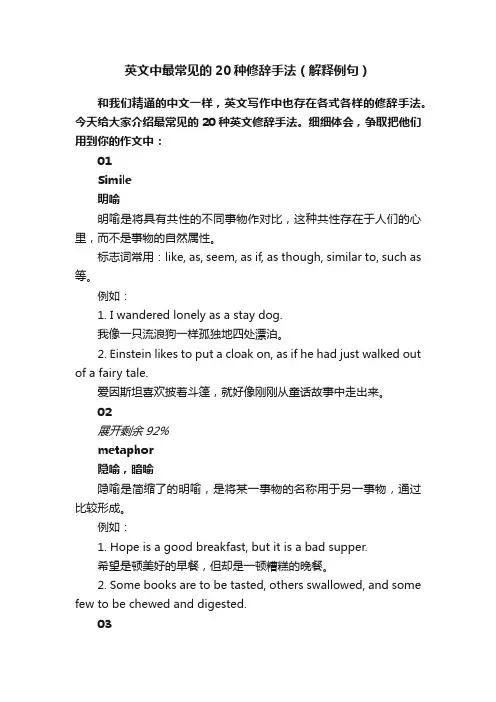
英文中最常见的20种修辞手法(解释例句)和我们精通的中文一样,英文写作中也存在各式各样的修辞手法。
今天给大家介绍最常见的20种英文修辞手法。
细细体会,争取把他们用到你的作文中:01Simile明喻明喻是将具有共性的不同事物作对比,这种共性存在于人们的心里,而不是事物的自然属性。
标志词常用:like, as, seem, as if, as though, similar to, such as 等。
例如:1. I wandered lonely as a stay dog.我像一只流浪狗一样孤独地四处漂泊。
2. Einstein likes to put a cloak on, as if he had just walked out of a fairy tale.爱因斯坦喜欢披着斗篷,就好像刚刚从童话故事中走出来。
02展开剩余92%metaphor隐喻,暗喻隐喻是简缩了的明喻,是将某一事物的名称用于另一事物,通过比较形成。
例如:1. Hope is a good breakfast, but it is a bad supper.希望是顿美好的早餐,但却是一顿糟糕的晚餐。
2. Some books are to be tasted, others swallowed, and some few to be chewed and digested.03metonymy借喻,转喻借喻不直接说出所要说的事物,而使用另一个与之相关的事物名称.1. 以容器代替内容,例如:1)The kettle boils.水开了。
2)The room sat silent.全屋人安静地坐着。
2. 以资料、工具代替事物的名称,例如:Lend me your ears, please.请听我说。
3. 以作者代替作品,例如:a complete Shakespeare莎士比亚全集4. 以具体事物代替抽象概念,例如:I had the muscle, and they made money out of it.我有力气,他们就用我的力气赚钱。
英语修辞手法45种
45种英语修辞(1)alliteration(押头韵):一组单词的第一个辅音相同.When the things happen that you do not like, you have two choices: You get bitter or better(2)metaphor(隐喻):利用某些单词进行含蓄的比喻,此时这些单词已经不再是字面上的意思了,Strawberries flooded the market and prices dropped down. (草莓充斥市场,价格下跌)。
(3)anadiplosis(联珠):将一个或一组单词重复多遍,Men in great place are thrice servants: servants of state, servants of fame, and servants of business.(4)anaphora(首语重复):将一个句子的开头单词或短语,在随后的句子中重复多遍.We shall fight on the seas and oceans, we shall fight on the beaches, we shall fight on the landing grounds, we shall fight in the fields and in the streets, we shall fight in the hills.(5)anastrophe(词序倒装): 改变正常词序,比如例句中最后一部分,正常词序是yet a breeze never blew up 。
The helmsman steered, the ship moved on, yet never a breeze up blew.(6)antistrophe(逆反复):在每个句子的结尾,重复相同的单词或短语,比如例句中的without warning。
英语中修辞手法
英语中有二十几种种修辞手法,它们分别是:Simile明喻、Metaphor隐喻/暗喻、Metonymy借喻/借代、Synecdoche提喻、Synaesthesia 通感、Personification拟人、Hyperbole夸张、Parallelism排比/平行、Euphemism 委婉、Allegory 讽喻,比方、Irony反语、Pun双关、Parody仿拟、Rhetorical question修辞疑问/反问、Antithesis对照/对比/对偶、Paradox隽语、Oxymoron矛盾修饰法、alliteration头韵法、transferred epithet移就、Allusion引用典故、Climax渐进法/层进法、Anticlimax渐降法。
1.Simile 明喻明喻是将具有共性的不同事物作对比。
这种共性存在于人们的心里,而不是事物的自然属性。
标志词常用 like, as, seem, as if, as though, similar to, such as等。
例如:1>.He was like a cock who thought the sun had risen to hear him crow.2>.I wandered lonely as a cloud.2.Metaphor 隐喻,暗喻隐喻是简缩了的明喻,是将某一事物的名称用于另一事物,通过比较形成。
例如:1>.He has a heart of stone.他铁石心肠。
2>.Some books are to be tasted, others swallowed, and some few to be chewed and digested.3.Metonymy 借喻,借代借喻不直接说出所要说的事物,而使用另一个与之相关的事物名称。
I.以容器代替内容,例如:1>.The kettle boils. 水开了。
20种英语修辞手法整理
20种英语修辞手法整理英语修辞手法是英语写作中常用的一种技巧,通过巧妙地运用修辞手法,可以增加文章的表现力和吸引力,使读者更加有兴趣阅读。
本文将整理介绍20种常见的英语修辞手法。
一、比喻(Metaphor)比喻是一种常见的修辞手法,用于通过将两个不相干的事物进行比较,以增强表达的效果。
例如:“他是一只勇敢的狮子。
”二、暗喻(Implicit Metaphor)暗喻是一种通过隐晦的方式进行比喻的修辞手法,不直接明示被比较的事物。
例如:“他是个夜猫子。
”三、拟人(Personification)拟人是将非人事物赋予人的特质或行为的修辞手法。
例如:“大地张开了它温暖的怀抱。
”四、夸张(Hyperbole)夸张是一种通过夸大事物的说法来产生强烈效果的修辞手法。
例如:“我等了一万年。
”五、对比(Contrast)对比是一种通过将两个不同或相反的事物进行相互对比,以突出差异或强调某一方面的修辞手法。
例如:“他的言行恰恰相反。
”六、排比(Parallelism)排比是一种通过对句子或短语进行平行结构的修辞手法,以强调重点或增加语句的节奏感。
例如:“奋斗,拼搏,追求,努力。
”七、倒装(Inversion)倒装是一种颠倒语序的修辞手法,常常用于疑问句或为了强调某一部分。
例如:“Never have I seen such a beautiful sunset.”八、反问(Rhetorical Question)反问是一种用疑问句的形式表达肯定或否定的修辞手法,常用于强调某一观点或引起读者思考。
例如:“难道你不想成功吗?”九、比较(Comparison)比较是通过将两个事物进行对比,以凸显共同点或差异的修辞手法。
例如:“学习就像是爬山,充满了艰辛和挑战。
”十、设问(Hypophora)设问是一种在文章中提出问题,并在下文中进行回答的修辞手法,常用于引起读者的关注和思考。
例如:“你知道成功的秘诀是什么吗?答案很简单——努力。
英语22种修辞手法以及例句归纳总结
英语22种修辞手法以及例句归纳总结常见英语修辞手法总共有22种,分别为明喻、转喻、提喻、隐喻、拟人、拟声、夸张、双关、讽刺、联觉、头韵、委婉、修辞反问、隽语、对照、渐进法、渐降法、引用、叠言、仿拟、排比、寓言。
一、明喻(Simile)是以两种具有相同特征的事物和现象进行对比,表明本体和喻体之间的相似关系,两者都在对比中出现。
常用比喻词like, as, as if, as though,seem,similar to, such as等,Eg:1. This elephant is like a snake as anybody can see.这头象和任何人见到的一样像一条蛇。
2. He looked as if he had just stepped out of my book of fairytales and had passed me like a spirit.他看起来好像刚从我的童话书中走出来,像一个幽灵一样从我身边走过。
3. It has long leaves that sway in the wind like slim fingers reaching to touch something.它那长长的叶子在风中摆动,好像伸出纤细的手指去触摸什么东西似的。
二、隐喻(Metaphor)这种比喻不通过比喻词进行,而是直接将用事物当作乙事物来描写,甲乙两事物之间的联系和相似之处是暗含的。
Eg:1、The diamond department was the heart and center of the store.钻石部是商店的心脏和核心。
2. He is a pig.他简直是头猪。
(比喻:他是一个像猪一般的人,指肮脏,贪吃的人。
)3. She is a woman with a stony heart.她是一个铁石心肠的女人。
(比喻:这个女人冷酷无情。
)4.Mark Twain is a mirror of America.马克•吐温是美国的一面镜子。
- 1、下载文档前请自行甄别文档内容的完整性,平台不提供额外的编辑、内容补充、找答案等附加服务。
- 2、"仅部分预览"的文档,不可在线预览部分如存在完整性等问题,可反馈申请退款(可完整预览的文档不适用该条件!)。
- 3、如文档侵犯您的权益,请联系客服反馈,我们会尽快为您处理(人工客服工作时间:9:00-18:30)。
1.Simile 明喻明喻是将具有共性的不同事物作对比.这种共性存在于人们的心里,而不是事物的自然属性.标志词常用like, as, seem, as if, as though, similar to, such as等.例如:1>.He was like a cock who thought the sun had risen to hear him crow.2>.I wandered lonely as a cloud.3>.Einstein only had a blanket on, as if he had just walked out of a fairy tale.2.Metaphor 隐喻,暗喻隐喻是简缩了的明喻,是将某一事物的名称用于另一事物,通过比较形成.例如:1>.Hope is a good breakfast, but it is a bad supper.2>.Some books are to be tasted, others swallowed, and some few to be chewed and digested.3.Metonymy 借喻,转喻借喻不直接说出所要说的事物,而使用另一个与之相关的事物名称.I.以容器代替内容,例如:1>.The kettle boils. 水开了.2>.The room sat silent. 全屋人安静地坐着.II.以资料.工具代替事物的名称,例如:Lend me your ears, please. 请听我说.III.以作者代替作品,例如:a complete Shakespeare莎士比亚全集VI.以具体事物代替抽象概念,例如:I had the muscle, and they made money out of it. 我有力气,他们就用我的力气赚钱.4.Synecdoche 提喻提喻用部分代替全体,或用全体代替部分,或特殊代替一般.例如:1>.There are about 100 hands working in his factory.(部分代整体)他的厂里约有100名工人.2>.He is the Newton of this century.(特殊代一般)他是本世纪的牛顿.3>.The fox goes very well with your cap.(整体代部分)这狐皮围脖与你的帽子很相配.5.Synaesthesia 通感,联觉,移觉这种修辞法是以视.听.触.嗅.味等感觉直接描写事物.通感就是把不同感官的感觉沟通起来,借联想引起感觉转移,“以感觉写感觉”。
通感技巧的运用,能突破语言的局限,丰富表情达意的审美情趣,起到增强文采的艺术效果。
比如:欣赏建筑的重复与变化的样式会联想到音乐的重复与变化的节奏;闻到酸的东西会联想到尖锐的物体;听到飘渺轻柔的音乐会联想到薄薄的半透明的纱子;又比如朱自清《荷塘月色》里的“ 微风过处送来缕缕清香,仿佛远处高楼上渺茫的歌声似的”。
例如:1>.The birds sat upon a tree and poured forth their lily like voice.(用视觉形容听觉,鸟落在树上,由它发出的声音联想到百合花)鸟儿落在树上,倾泻出百合花似的声音.2>.Taste the music of Mozart.(用嗅觉形容听觉)品尝Mozart的音乐.6.Personification 拟人拟人是把生命赋予无生命的事物.例如:1>.The night gently lays her hand at our fevered heads.(把夜拟人化)2>.I was very happy and could hear the birds singing in the woods.(把鸟拟人化)7.Hyperbole 夸张夸张是以言过其实的说法表达强调的目的.它可以加强语势,增加表达效果..例如:1>.I beg a thousand pardons.2>.Love you. You are the whole world to me, and the moon and the stars.3>.When she heard the bad news, a river of tears poured out.8.Parallelism 排比, 平行这种修辞法是把两个或两个以上的结构大体相同或相似,意思相关,语气一致的短语.句子排列成串,形成一个整体.例如:1>.No one can be perfectly free till all are free; no one can be perfectly moral till all are moral; no one can be perfectly happy till all arehappy.2>.In the days when all these things are to be answered for, I summon you and yours, to the last of your bad race, to answer for them. In the days when all these things are to be answered for, I summon your brother, the worst of your bad race, to answer for them separately.9.Euphemism 委婉,婉辞法婉辞法指用委婉,文雅的方法表达粗恶,避讳的话.例如:1>.He is out visiting the necessary.?? 他出去方便一下.2>.His relation with his wife has not been fortunate. 他与妻子关系不融洽.3>.Deng Xiaoping passed away in 1997. (去世)10.Allegory 讽喻,比方(原意“寓言”)建立在假借过去或别处的事例与对象之上,传达暗示,影射或者讥讽现世各种现象的含义。
英文解释:an expressive style that uses fictional characters and events to describe some subject by suggestive resemblances; an extended metaphor 摘自英语专业《大学英语教程》一书这是一种源于希腊文的修辞法,意为"换个方式的说法".它是一种形象的描述,具有双重性,表层含义与真正意味的是两回事.例如:1>.Make the hay while the sun shines.表层含义:趁着出太阳的时候晒草真正意味:趁热打铁2>.It's time to turn plough into sword.表层含义:是时候把犁变成剑11.Irony 反语反语指用相反意义的词来表达意思的作文方式.如在指责过失.错误时,用赞同过失的说法,而在表扬时,则近乎责难的说法.例如:1>.It would be a fine thing indeed not knowing what time it was in themorning.早上没有时间观念还真是一件好事啊(真实含义是应该明确早上的时间观念)2>"Of course, you only carry large notes, no small change on you. "the waiter said to the beggar.12.Pun 双关双关就是用一个词在句子中的双重含义,借题发挥.作出多种解释,旁敲侧击,从而达到意想不到的幽默.滑稽效果.它主要以相似的词形.词意和谐音的方式出现.例如:1>.She is too low for a high praise, too brown for a fair praise and too little for a great praise.2>.An ambassador is an honest man who lies abroad for the good of his country.3>.If we don't hang together, we shall hang separately.13.Parody 仿拟这是一种模仿名言.警句.谚语,改动其中部分词语,从而使其产生新意的修辞.例如:1>.Rome was not built in a day, nor in a year.2>.A friend in need is a friend to be avoided.3>.If you give a girl an inch nowadays she will make address of it.14.Rhetorical question 修辞疑问(反问)它与疑问句的不同在于它并不以得到答复为目的,而是以疑问为手段,取得修辞上的效果,其特点是:肯定问句表示强烈否定,而否定问句表示强烈的肯定.它的答案往往是不言而喻的.例如:1>.How was it possible to walk for an hour through the woods and see nothing worth of note?2>.Shall we allow those untruths to go unanswered?15.Antithesis 对照,对比,对偶这种修辞指将意义完全相反的语句排在一起对比的一种修辞方法.例如:1>.Not that I loved Caeser less but that I loved Romemore.2>.You are staying; I am going.3>.Give me liberty, or give me death.16.Paradox 隽语这是一种貌似矛盾,但包含一定哲理的意味深长的说法,是一种矛盾修辞法..例如:1>.More haste, less speed.欲速则不达2>.The child is the father to the man.(童年时代可决定人之未来)三岁看大,四岁看老。
